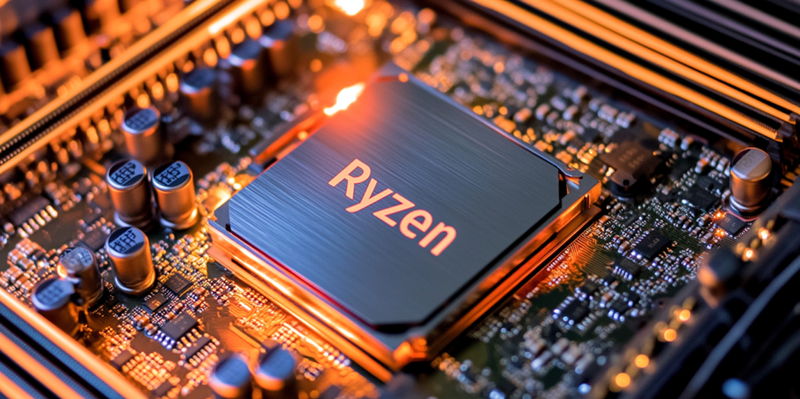AMD’s latest high-end CPUs, the Ryzen 9 9950X3D and Ryzen 9 9900X3D, are set to make a significant impact in the market when they officially launch in late January 2025. Previewed during CES 2025, these processors are designed with enthusiast gamers in mind, promising powerful performance and a host of advanced features. These new CPUs are the latest additions to AMD’s Zen 5-based Ryzen 3D V-Cache lineup, continuing the successful legacy of the Ryzen 7 9800X3D. They feature embedded Second-Generation V-Cache and full overclocking support, which positions them as top contenders in the high-performance computing segment.
Key Specifications
Ryzen 9 9950X3D: A Performance Powerhouse
The Ryzen 9 9950X3D stands out with its impressive 16 cores and 32 threads configuration, making it a powerhouse for both gaming and high-performance tasks. This CPU features a single CCD V-Cache complemented by 64 MB of base cache and an additional 64 MB of 3D V-Cache, resulting in a total of 128 MB, further supported by an additional 16 MB of L2 cache. These combined figures yield a substantial 144 MB cache pool, which is expected to significantly enhance the performance of cache-sensitive applications like gaming and content creation.
While exact clock speeds and TDP (Thermal Design Power) values have not been explicitly confirmed for the Ryzen 9 9950X3D, comparisons with existing models provide some insight. For instance, the Ryzen 7 9800X3D features a TDP of 120W, which is higher compared to the 65/105W TDP found in the Ryzen 7 9700X. Given this, it’s speculated that AMD might either apply a similar 120W TDP to the 9950X3D or potentially increase it to 170W to accommodate the increased performance requirements. Despite these higher TDPs, AMD’s new 3D V-Cache CPUs are renowned for their efficiency and low power consumption during gaming sessions, offering additional TDP headroom for multi-threaded tasks or overclocking scenarios.
Ryzen 9 9900X3D: Balancing Power and Performance
The Ryzen 9 9900X3D, on the other hand, caters to users seeking a balance between power and efficiency. With 12 cores and 24 threads, it retains the single-CCD V-Cache die design, boasting an impressive total L2 + L3 cache pool of 140 MB. This copious amount of cache, although slightly smaller than the 9950X3D, provides a substantial boost to performance, particularly in tasks that rely heavily on cache memory, such as intricate gaming environments and complex computational workloads.
Similar to the 9950X3D, the 9900X3D’s clock speeds and TDP values remain speculative based on previous models in the lineup. If the TDP follows the trend set by the Ryzen 7 9800X3D, it might be around 120W, but there’s also a possibility for an increase based on performance targets. Regardless of the final TDP, these CPUs are designed to maintain a balance between high-performance capabilities and energy efficiency, making them suitable for a wide range of applications, from gaming to professional content creation and beyond.
Performance and Innovation
Gaming Efficiency and Enhanced Caching
One of the standout features of AMD’s new 3D V-Cache CPUs, including the Ryzen 9 9950X3D and 9900X3D, is their exceptional gaming efficiency. The advanced caching mechanism significantly reduces latency, providing faster access times to frequently used data. This is particularly beneficial for gaming where rapid data retrieval can give gamers a crucial edge. Embedded Second-Generation V-Cache technology ensures that these processors can handle the most demanding gaming scenarios with ease, delivering smooth and immersive experiences.
Moreover, the substantial L2 and L3 cache capacities of these CPUs minimize the need for frequent data fetching from the slower main memory, resulting in more efficient processing. This improved efficiency translates to lower power consumption during gaming, which is a critical factor for gamers who demand both performance and energy savings. By leveraging the 3D V-Cache technology, AMD continues to push the boundaries of what’s possible in gaming performance, setting new standards for gaming CPUs.
Flexible Power Consumption Standards
Another notable aspect of these new Ryzen 3D V-Cache CPUs is their flexible power consumption standards, which cater to high-end performance needs. The TDP headroom provided by these processors allows users to push the limits of performance without compromising on efficiency. This flexibility is particularly important for users who engage in multi-threaded tasks or those who wish to explore the capabilities of overclocking. The additional power handling capacity ensures that the CPUs can scale their performance based on the specific demands of the application, offering a dynamic balance between power and efficiency.
AMD’s commitment to innovation in power management is evident in these new processors, which are designed to deliver optimal performance across a variety of scenarios. Whether it’s gaming, content creation, or professional workloads, the Ryzen 9 9950X3D and 9900X3D are equipped to handle diverse computing needs efficiently. This adaptability underscores AMD’s dedication to providing versatile and high-performance solutions for modern computing challenges.
Conclusion
AMD is gearing up to make waves with its latest high-end CPUs, the Ryzen 9 9950X3D and Ryzen 9 9900X3D, slated to launch in late January 2025. Unveiled at CES 2025, these cutting-edge processors are tailored for enthusiast gamers, touting powerful performance and an array of advanced features. These new additions to AMD’s Zen 5-based Ryzen 3D V-Cache lineup follow in the footsteps of the highly successful Ryzen 7 9800X3D. Equipped with Second-Generation V-Cache technology and full overclocking support, they promise to elevate the high-performance computing experience to new heights.
The importance of these processors lies not only in their specifications but also in their ability to push the boundaries of gaming and professional applications. Enthusiasts can expect a substantial boost in speed and efficiency, making these CPUs a top choice for anyone looking to maximize their system’s capabilities. Furthermore, the overclocking support allows users to tweak and customize performance to meet their specific needs, offering unprecedented control and flexibility in high-performance computing.

